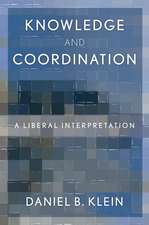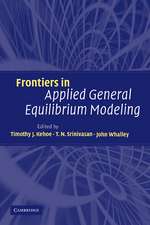Growth and Income Distribution: Essays in Economic Theory
Autor Luigi L. Pasinettien Limba Engleză Paperback – 28 feb 1979
Preț: 352.92 lei
Nou
Puncte Express: 529
Preț estimativ în valută:
67.53€ • 72.21$ • 56.31£
67.53€ • 72.21$ • 56.31£
Carte tipărită la comandă
Livrare economică 18 aprilie-02 mai
Preluare comenzi: 021 569.72.76
Specificații
ISBN-13: 9780521295437
ISBN-10: 0521295432
Pagini: 164
Ilustrații: black & white illustrations
Dimensiuni: 140 x 216 x 10 mm
Greutate: 0.21 kg
Ediția:Revised
Editura: Cambridge University Press
Colecția Cambridge University Press
Locul publicării:Cambridge, United Kingdom
ISBN-10: 0521295432
Pagini: 164
Ilustrații: black & white illustrations
Dimensiuni: 140 x 216 x 10 mm
Greutate: 0.21 kg
Ediția:Revised
Editura: Cambridge University Press
Colecția Cambridge University Press
Locul publicării:Cambridge, United Kingdom
Cuprins
Preface; Part I. A Mathematical Formulation of the Ricardian System: 1. Theory of value; 2. Theory of distribution; 3. Theory of economic growth; 4. 'Natural' equilibrium in a two-commodity system; 5. Some characteristics of the Ricardian system; 6. The market solutions and the attainment of the 'natural' equilibrium; 7. The equilibrium of the stationary state; 8. The process of economic growth; 9. Multi-commodity production; 10. Concluding remarks; Appendix - existence and uniqueness of stable solutions; Part II. The Economics of Effective Demand: 1. Malthus on effective demand; 2. The principle of effective demand; 3. Theories of under-consumption (And over-production) 4. J. M. Keynes' 'general theory' of employment; 5. The principle of effective demand in a different context; 6. Ricardian features of effective demand in a different context. 7. Anti-Keynesian features of some 'Keynesian' literature; 8. The principle of acceleration; 9. Final remarks; Appendix - the 'lagged' multiplier; Part III. Cyclical Fluctuations and Economic Growth: 1. The model; 2. A graphical device; 3. The dynamics of income; 4. The dynamics of the stock of capital; 5. Interrelations between the dynamics of capital; 6. The various interpretation of the endogenous dynamics of an economic system; 7. Possibility of a steady growth; 8. The difficulties of providing a theory which may explain both cycles and growth; 9. A more flexible use of macro-economic models; 10. A reinterpretation of the complex dynamics of a modern economic system; Mathematical appendix; Part IV. From Classical to Keynesian Economic Dynamics: 1. Pre-Malthusian Views on Population; 2. Malthus' Principle of population; 3. The 'law of diminishing returns'; 4. Population growth and technical progress; 5. Long-run equilibrium conditions - Domanr's contribution; 6. The 'natural rate of growth - Harrod's contribution; 7. New answer to an old Ricardian problem; 8. Kaldor's theory of income distribution; 9. Concluding remarks; Part V. Rate of Profit and Income Distribution in relation to the Rate of Economic Growth: 1. A post-Keynesian theory of income distribution and the rate of profit; 2. A correction; 3. Reformulating the model; 4. Rate and share of profits in relation to the rate of growth; 5. A fundamental relation between profits and savings; 6. Implications; 7. The conditions of stability; 8. The case of a socialist system; 9. Models and reality; Part VI. The Rate of Profit in and Expanding Economy: 1. Harrod–Domar's dilemma; 2. The 'Cambridge equation'; 3. The marginal productivity alternative; 4. Extreme assumptions and general results; 5. A first approximation synthesis; 6. Irrelevance of the workers' savings required for the disappearance of the capitalists; 9. Capital-output ratio and rate of profit; 10. The case of a highly flexible capital-output ratio; 11. Conclusions for the general case; 12. Rate of interest and rate of profit; 13. Many groups of savers; 14. Further extensions; 15. A socialist economy; 16. The rate of profit in an expanding economy; References; Index.
Descriere
This 1974 collection of six essays in economic theory represents a major contribution to the field.
















